Crickhowell
Crickhowell (/krɪkˈhaʊəl/; Welsh: Crucywel pronounced [krɨkːəu̯ɛl], non-standard spelling Crughywel) is a town and community in southeastern Powys, Wales, near Abergavenny, and is in the historic county of Brecknockshire.
Crickhowell
| |
|---|---|
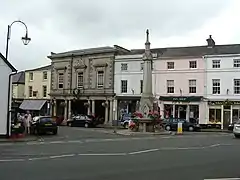 Crickhowell Market Hall and the Lucas Memorial Fountain | |
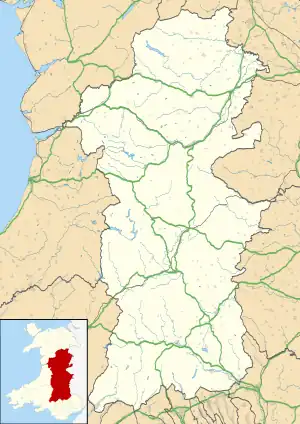 Crickhowell Location within Powys | |
| Population | 2,063 (2011)[1] |
| OS grid reference | SO217186 |
| Principal area | |
| Preserved county | |
| Country | Wales |
| Sovereign state | United Kingdom |
| Post town | CRICKHOWELL |
| Postcode district | NP8 |
| Dialling code | 01873 |
| Police | Dyfed-Powys |
| Fire | Mid and West Wales |
| Ambulance | Welsh |
| UK Parliament | |
| Senedd Cymru – Welsh Parliament | |
Location
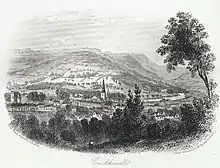
.jpg.webp)
The town lies on the River Usk, on the southern edge of the Black Mountains and in the eastern part of the Brecon Beacons National Park. Significant parts of the surrounding countryside, over 20,000 acres (81 km2), form part of the Glanusk Park estate.[2]
Etymology and language
The name Crickhowell is an anglicised spelling that corresponds to the Welsh Crucywel. The name is derived from Crug Hywel, meaning 'Hywel's mound'. This is usually identified with the Iron Age hill fort on nearby Table Mountain, although this has the local name of Mynydd y Begwn. It may be that Crug Hywel refers to the castle mound in the town itself.[3] The language of Crickhowell (and Llangynidr) was originally Welsh. In his 1893 book Wales and her language, John E. Southall, reports that over 60% of the population of Crickhowell spoke Welsh, although the town was only a few miles from more anglicised Abergavenny.[4]
The town
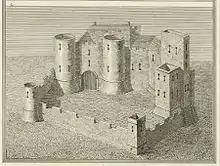
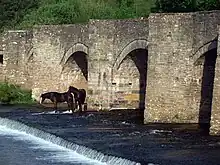
Public services in Crickhowell are provided by Powys County Council and to a lesser extent by Crickhowell Town Council. Planning matters fall to the Brecon Beacons National Park Authority. There is a primary school and a secondary school; both act as a central point for a large catchment area. There is some light industry on the outskirts of Crickhowell at the Elvicta Industrial Estate. The town centre[5] includes a variety of traditional businesses, many of which are family owned. Other facilities in Crickhowell include a library, two play areas, public toilets and the CRiC building, which houses a tourist information centre, an internet cafe, an art gallery and a local history archive. There are pubs, cafes, restaurants and two hotels: "The Bear" and "The Dragon".[6]
The churches in Crickhowell include St Edmund's Church which holds a service every Sunday, Crickhowell Evangelical Church,[7] a Baptist church and a Catholic church.[8]
In 2015, Crickhowell appeared in a TV documentary, claiming it as the first British settlement to purposely use similar tax avoidance tactics used by multinational businesses to avoid paying taxes themselves, in protest at the way large corporations use legal loopholes to avoid paying UK corporation tax.[9]
A market and fair have been recorded since 1281.[10]
Governance
An electoral ward in the same name exists. This ward includes The Vale of Grwyney community and has a total population of 2,801 as of the 2011 census.[11] The current councillor is John Morris, a Liberal Democrat.[12]
Tourism
Today, Crickhowell is a popular tourist destination. In 2005 a tourist information centre was built in the centre of town and during summer the town is notably busier. Many people visit Crickhowell to see the Black Mountains and the Brecon Beacons, and perhaps to enjoy some mountain-biking, camping, hillwalking, rock climbing, fly-fishing, hang-gliding or caravanning, or simply to tour the area by car, staying in bed-and-breakfast accommodation. The Green Man Festival takes place annually in mid-August at nearby Glanusk Park.[13]
Notable buildings
Notable features in Crickhowell include the seventeenth-century stone bridge over the River Usk with its odd arches (twelve on one side, thirteen on the other) and its seat built into the walls, the 14th-century parish church of St Edmund, and the ruins of Crickhowell Castle on the green "tump" set back from the A40 Brecon to Abergavenny road.[14]
Market Hall
Crickhowell Market Hall (originally the Town Hall) on The Square dates from 1834, nowadays with market stalls on the ground floor and a cafe in the first floor old courtroom. In 2007 Powys County Council handed over responsibility of the hall to a charity, the Market Hall Trust.[15] The stone building, raised on twin doric columns, is Grade II* listed.[16]
Schools
Crickhowell has two schools: Crickhowell Community Primary School and a secondary school, Crickhowell High School.[17]
Notable people
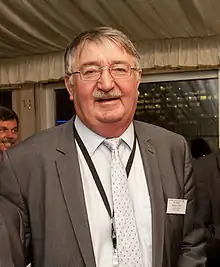
- Watkin Herbert (ca.1517 – ca.1564), a politician and MP for Breconshire in 1558.
- Admiral John Gell (1740–1806), a commander in the Royal Navy for 30 years, died locally.[18]
- Colonel Sir George Everest (1790–1866), eponym for Mount Everest. Surveyor and geographer, served as Surveyor General of India from 1830 to 1843. His father had an estate nearby called "Gwernvale Manor".[19]
- Admiral Sir Walter Cowan, 1st Baronet (1871–1956), a Royal Navy officer in both World Wars
- Nicholas Edwards, Baron Crickhowell (1934–2018), politician and MP for Pembrokeshire from 1970 until 1987 and Secretary of State for Wales
- Sir Roderic Llewellyn, 5th Baronet (born 1947), baronet, garden designer, journalist, author, and TV presenter.
- Roger Williams (born 1948), politician and MP for Brecon and Radnorshire from 2001 to 2015.
- Martyn Farr (born 1951), exploratory cave diver and caver
- Mark Wyatt (born 1957), played ten games for Wales national rugby union team
- Tiggy Legge-Bourke (born 1965), former royal nanny. Her childhood home was Glanusk Park estate. She still lives near the town as proprietor of Tŷ'r Chanter bed and breakfast lodgings.[20]
Golf course
The former Crickhowell & Penmyarth Golf Club was founded in 1897 and played on a course at Glanusk Park. The club and course disappeared in the late 1960s.[21]
Surrounding villages
- Cwmdu[22]
- Glangrwyney[23]
- Llanbedr[24][25]
- Llangattock[26][27]
- Llangenny[28]
- Llangynidr[29][30]
- Tretower—[31] Tretower Castle and Tretower Court, a manor house still in very good condition
Cwrt y Gollen, a British Army training base, is near Crickhowell.
References
- "Town population 2011". Archived from the original on 4 March 2016. Retrieved 10 November 2015.
- "Glanusk Park". Victorian Crickhowell. Retrieved 10 June 2022.
- Hywel Wyn Owen and Richard Morgan, Dictionary of the Place-Names of Wales (Llandysul: Gomer Press, 2007), p. 102.
- Southall, John E. (1893). Wales and her language. D. Nutt.
- "Crickhowell High Street (C) George Tod". www.geograph.org.uk.
- "Welcome". The Dragon. Retrieved 10 June 2022.
- "Crickhowell Evangelical Church".
- "St Joseph Catholic Church". Catholic Directory. Retrieved 10 June 2022.
- "The town that took itself offshore to expose tax avoiders". Independent.co.uk. 10 November 2015.
- "Wales - British History Online". www.british-history.ac.uk.
- "Ward population 2011". Retrieved 10 November 2015.
- "Your Councillors". powys.moderngov.co.uk (in Welsh). 22 July 2019. Retrieved 22 July 2019.
- Sherwin, Adam (1 December 2013). "'It's nice to go bonkers in a field': The Green Man music festival's". The Independent. Archived from the original on 3 May 2019. Retrieved 21 March 2020.
- Cadw. "Crickhowell Castle (7192)". National Historic Assets of Wales. Retrieved 10 June 2022.
- Martin Shipton (7 August 2008) "Cafe war breaks out over market hall", Wales Online. Retrieved 15 August 2017.
- Cadw. "Town Hall (7211)". National Historic Assets of Wales. Retrieved 15 August 2017.
- "Welcome". Crickhowell High School. Retrieved 19 October 2010.
- The Literary Panorama. Cox, Son and Baylis. 1807. p. 1385. Retrieved 27 January 2016.
- "George Everest was born on 4 July 1790 but the location is open to doubt. This uncertainty as to his birthplace arises because his father William Tristram Everest had an estate near Crickhowell in South Wales and some reference works suggest he was born there. [...] George's baptismal certificate certainly indicates that he was baptized in Greenwich but although the certificate also bears his date of birth it does not indicate the locality."
Smith, James R. (2015). "Sir George Everest". In Martin, Geoffrey (ed.). Geographers: Biobibliographical Studies, Volume 15. Bloomsbury Publishing. ISBN 9781474226653. - The Tiggy Experience Archived 8 February 2008 at the Wayback Machine at tyrchanter.com, official web site. Retrieved 1 February 2008.
- "Crickhowell & Penmyarth Golf Club, Glanusk Park, Powys". Golf's Missing Links.
- "Church of the Archangel Michael, Cwmdu (C) Jonathan Billinger". www.geograph.org.uk.
- "The Blue Bell Inn (C) Jennifer Luther Thomas". www.geograph.org.uk.
- Ian Rushin. "Llanbedr Church and Table Mountain". www.geograph.org.uk.
- Ian Rushin. "Llanbedr below Sugar Loaf". www.geograph.org.uk.
- "Monmouthshire & Brecon Canal,... (C) George Tod". www.geograph.org.uk.
- "Llangattock (C) Jonathan Billinger". www.geograph.org.uk.
- "Descending the Sugar Loaf towards... (C) John Thorn". www.geograph.org.uk.
- "Llangynidr Bridge in spring (C) Alan Bowring". www.geograph.org.uk.
- "Mynydd Llangynidr (C) Peter Wasp". www.geograph.org.uk.
- "Tretower Court (C) andy dolman". www.geograph.org.uk.
